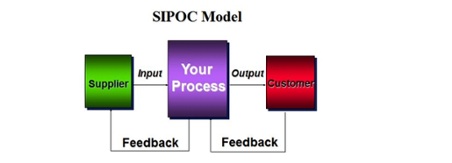 The Lean Six Sigma (LSS) methodology that was originally developed in manufacturing is slowly making its way to the education space. As the concepts of Lean Six Sigma spread and provide the template for improving efficiency and enhancing institutional performance, the SIPOC tool is invaluable for changing the thinking and approach to project management, process improvement and LSS implementation.
The Lean Six Sigma (LSS) methodology that was originally developed in manufacturing is slowly making its way to the education space. As the concepts of Lean Six Sigma spread and provide the template for improving efficiency and enhancing institutional performance, the SIPOC tool is invaluable for changing the thinking and approach to project management, process improvement and LSS implementation.

What is SIPOC – the acronym for supplier, input, process, output, customer.
The SIPOC is the first place to get started. It provides a definition of the problem, a high level outline of the process, a method to define the scope of any project, and a way to refine the problem statement before beginning a project. If this model is not used to define a process or project, it is possible that individuals may stumble along without being able to achieve the desired output
 Based on my experience working in education there are a number of things that contribute to the need to use this model:
Based on my experience working in education there are a number of things that contribute to the need to use this model:
- A strong silo culture. A strong functional structure that often prohibits collaboration.
- Lack of an understanding of the chain of customers who need to work together to satisfy the needs of the ultimate customer
- The inability to identify the immediate customer and understand their requirements
- Inability to identify deliverables and outputs
- Lack of process measurements or leading indicators
- Large volumes of data but no information. Decisions are not driven by the use and understanding of data
- Lack of a process focus –poor process identification and definition
The list goes on. But why is this important? The inabilities to address this thought process creates waste and will inevitable prevent the efficiency and performance required for us to improve the level of education in the US as well as our ability to compete in a global environment.
 This past week, in a Lean Six Sigma training and workshop for Higher Education we discussed and used this tool as an important step to outline the scope of the Lean Six Sigma projects. Process Mapping and eventually process management cannot occur before first developing the SIPOC diagram. Whenever I am told that an organization is using processes, but did not begin with the SIPOC diagram then the accuracy and scope of the process may be in question. Processes in education are often very hard to define so the use of this model provides a structure and a way of thinking that ensures success.
This past week, in a Lean Six Sigma training and workshop for Higher Education we discussed and used this tool as an important step to outline the scope of the Lean Six Sigma projects. Process Mapping and eventually process management cannot occur before first developing the SIPOC diagram. Whenever I am told that an organization is using processes, but did not begin with the SIPOC diagram then the accuracy and scope of the process may be in question. Processes in education are often very hard to define so the use of this model provides a structure and a way of thinking that ensures success.
Another critical component is the use of a feedback loop that enhances communication between the process and the customers that are served and between the suppliers and the input they provide. Without a feedback system the process may not be valuable and will eventually deteriorate.

How to Use the SIPOC model in Higher Education
Although a seemingly simple tool, the SIPOC diagram has tremendous value when organizations seem to have a rigid silo culture. Once a project is selected and a team is formed, answers to the following questions must be addressed
1. What is the purpose of the project – why is the project being done
2. What is the process –
- Provide a name for the process
- Outline the boundaries of the process
- Where does the process start
- Where does the process end
- What are the top five activities performed within the boundaries of the process.
3. What is the output of the process? These are the deliverables of the process that need to be identified in countable units.
4. Who are the customers of the process – individuals impacted by the output of the process
5. What are the requirements of the customers- internal and external customers?
6. How are the outputs to be used by the internal or external customers?
7. What is the feedback system between the process and the customers
8. What does the process require to get started – inputs
9. Who provides the inputs to the process -suppliers
10. What is the feedback system between the suppliers and the process
Answers to these questions provide a good template for an effective SIPOC model and a strong foundation for change and process improvement.
Conclusions
The concepts outlined are fundamental to the underlying principles of Lean Six Sigma and emphasize the ideas of value added and non-value added. In addition, it promotes collaboration in institutions by bringing academic and non-academic areas together to achieve a common objective. In some cases when I have introduced SIPOC to individuals in education systems it has made an extraordinary difference in how they view their jobs and in some cases served as a strong motivating factor.
Lean Six Sigma Master Black Belt, Hands-on performance improvement expert, President Performance Innovation LLC . Article used with permission. Originally published at:
http://www.performance-innovation.com/blog/lean-six-sigma-and-the-sipoc-tool-for-higher-education
Bio:
NORMA S. SIMONS, MS, Industrial Engineering/ Operations Research, is a Lean Six Sigma Consultant & Master Black Belt and is the President of Performance Innovation LLC, formerly Simons-White & Associates, a technical and professional development training and consulting firm. For over 20 years, Ms. Simons, has been committed to providing companies with customized performance solutions that yield bottom-line results. Her success can be contributed to her unique integration of performance improvement systems such as Lean, Six Sigma, Quality Management Systems, Business Operating Systems, and Balanced Scorecards, that have enabled the effective execution of organizational strategy and ultimately bottom-line results.President
Performance Innovation LLC
39555 Orchard Hills Place
Suite 600
Novi, Michigan 48375
Office: 248 529 6701
Cell: 248 417 076